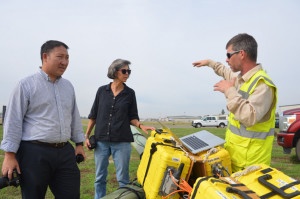
With the increasing issue of the California drought, a Stanford-led project is using a new technique to detect underground water without having to reach it. Taking advantage of existing technology originally developed for finding other natural resources, the scientists hope to increase the efficiency of well-drilling for water.
The technology, which consists of a giant 80-foot hexagon of electrical equipment suspended from a helicopter, was created by the Danish company SkyTEM, with “TEM” standing for “transient electromagnetism.” The system has already been used in other sectors such as oil, gas and mineral exploration, but never in the context of the Californian drought.
“Why drill when you’re not connected to water? You’re buying yourself a $200,000 dry well,” said Aaron Fukuda of the Tulare Irrigation District in a San Jose Mercury News article. “With this, we won’t be guessing every time.”
In order to detect the presence of water, electromagnetic pulses are aimed at the ground to obtain conductivity measurements for different substances in the earth. This data helps build 3D images that help scientists understand the materials hiding hundreds of feet below ground — including whether or not those materials are water-saturated.
“Medical imaging has revolutionized our approach to human health,” Stanford professor of environmental geophysics Rosemary Knight, a leader in the project to curb inefficient well drilling, told the Mercury. “This lets us do the same thing for groundwater, probing very deep.
Before, engineers would have to use predictions and generalizations to decide where to probe in hopes of finding water. Fukuda explained that with the practices in place today, when growers ask him how deep they should make new wells, he is forced to show them U.S. Geological Survey reports that are difficult to apply specifically and accurately.
Now, scientists will have definitive proof of the presence of water — saving time and money.
Contact Yael Lederman at yael3 ‘at ‘ stanford.edu.
